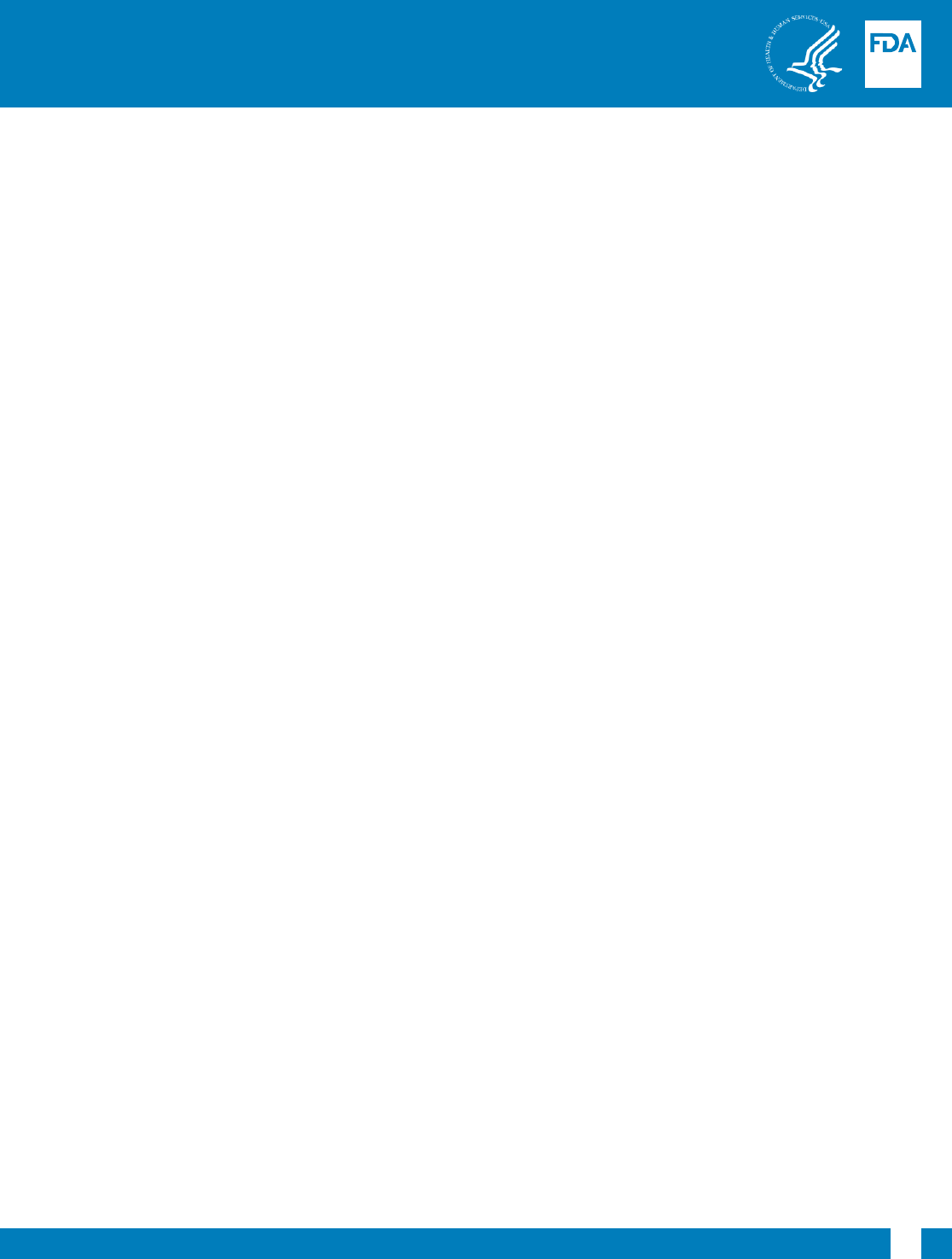
U.S. Department of Health & Human Services U.S. Food and Drug Administration
1
Menu Labeling Rule
Key Facts for Industry
General Information
Introduction
FDA published the final rule for menu labeling on December 1, 2014, and the compliance date was
May 7, 2018.
The rule requires that certain restaurants and similar retail food establishments provide consumers
with calorie and other nutrition information for standard menu items. The goal is to provide
consumers with nutrition information in a clear and consistent manner to enable them to make
informed and healthy dietary choices for themselves and their families when eating foods away from
home.
Overview of the Requirements
The menu labeling rule requires covered establishments to:
• Disclose calories for standard menu items listed on menus and menu boards;
• Disclose calories for foods on display and self-service foods that are standard menu items;
• Include on menus and menu boards a succinct statement concerning suggested caloric intake and a
statement that additional nutrition information is available upon request; and
• Have the required additional written nutrition information available upon consumer request
on the premises of the covered establishment.
Covered Establishments
Establishmen
ts that must meet the requirements of the rule (referred to as covered
establishments) are restaurants and similar retail food establishments selling restaurant-type
food that are:
• Part of a chain with 20 or more fixed locations;
•
Doing business under the same name; and
• Offering for sale substantially the same menu items.
Covered establishments may include:
• Restaurants (quick service and sit-down)
• Grocery and convenience stores
• Food takeout facilities and delivery services
• Entertainment venues
• Cafeterias
• Coffee shops
•
Superstores
• Some managed food service operations

2
U.S. Department of Health & Human Services U.S. Food and Drug Administration
Voluntary Registration
Restaurants or similar retail food establishments that do not meet the requirements of a covered
establishment may voluntarily register to be subject to the Federal requirements. State and localities
cannot impose additional or different nutrition labeling requirements for food sold at establishments
that voluntarily register. Establishments may voluntarily register and renew their registration every
other year by submitting FDA Form 3757, available online at the FDA.GOV website at:
https://www.fda.gov/Food/GuidanceRegulation/GuidanceDocumentsRegulatoryInformation/LabelingN
utrition/ucm515020.htm.
They may submit forms via:
• Email to CalorieLabeling@fda.hhs.gov with the subject line “FDA Form 3757”;
• Fax to 301-436-2636; or
• Mail to FDA, CFSAN Menu and Vending Registration, Office of Nutrition and Food Labeling,
HFS-800, 5001 Campus Drive, College Park, MD 20740
Restaurant-Type Foods
The rule defines restaurant-type foods as those that are usually eaten on the premises, while walking
away, or soon after arriving at another location, including:
• Meals served at sit-down restaurants
• Foods purchased at a drive through
• Takeout and delivery foods
• Hot buffet foods
• Foods ordered from a menu or menu board at a grocery store and intended for immediate
consumption
• Foods that are self-service and intended for immediate consumption
Foods That Are Generally Covered
• Standard menu items
(including alcoholic beverages)
• Combination meals
• Variable menu items
• Food on display
(including “grab and go” items)
• Self-service food and beverages
Foods That Are Exempt
•
Custom orders
• Daily specials
• Foods that are part of a customary
market test
• Temporary menu items
• General use condiments
• Foods that are not on a menu or menu
board and are not on display or self-service
Menus and Menu Boards
The rule defines menus and menu boards as the primary writing of the covered establishment from
which a customer makes an order selection. An establishment may have more than one primary
writing
; the critical factor is whether the written material is or is part of the primary writing of a
covered establishment from which a customer makes an order selection. Primary writings may include:
• Breakfast, lunch, and dinner menus
• Specialty menus (e.g., drink, dessert, and catering menus)
• Children’s menus
• Menu boards at a drive through
• Electronic menus and menu boards
• Online menus if the customer can order online or by phone

U.S. Department of Health & Human Services U.S. Food and Drug Administration
3
Marketing Material
Marketing material (e.g., pizza coupons, posters in store windows, signs on gas pumps, or paper
inserts) generally would not be considered a menu or menu board and would not require calorie
declarations. Written material of an establishment that does not satisfy the criteria of a primary
writing from which a customer makes an order selection (such as a poster on a storefront, a
coupon, or other promotional material, banners, billboards, and stanchions) would be considered
a “secondary writing” of an establishment. If the primary purpose of these materials is to “entice”
customers into the covered establishment, then we would not consider them to be a primary writing,
and they would not require calorie declarations.
The Succinct Statement and Statement of Availability
The succinct statement “2,000 calories a day is used for general nutrition advice, but calorie needs vary”
must appear on the bottom of menu boards and at the bottom of each page of multi-page menus, and
must meet certain size and color requirements.
The statement of availability “Additional nutrition information available upon request” must appear on
the bottom of the first page of a menu that lists standard menu items and at the bottom of the menu
board, and must meet certain size and color requirements. For information about certain size and
color requirements, please see the menu labeling final rule and final guidance for industry.
The succinct statement and the statement of availability must be provided for food that is self-service
or on display. They may be on the individual sign adjacent to the food itself, or on a separate, larger
sign in close proximity to the food. The customer must be able to easily read the sign when making
a selection.
Additional Written Nutrition Information
The additional written nutrition information
1
must include:
• Total calories (cal)
• Total fat (g)
• Saturated fat (g)
• Trans fat (g)
• Cholesterol (mg)
• Sodium (mg)
• Total carbohydrate (g)
• Dietary fiber (g)
•
Sugars (g)
• Protein (g)
A simplified format may be used for standard menu items (e.g., alcohol and soft drinks) that contain
insignificant amounts of six or more of the required nutrients. This format must:
• Include information on total calories, total fat, total carbohydrates, protein, and sodium and any
other of the required nutrients that are present in more than insignificant amounts; and
• Include, at the bottom of the list of nutrients, the statement “Not a significant source of
”
(with the blank filled in with the required nutrients that are present in insignificant amounts).
1
The additional written nutrition information required in 21 CFR 101.11(b)(2)(ii)(A) includes calories from fat, however FDA
announced in the Supplemental Guidance our intent to exercise enforcement discretion regarding the “calories from fat”
nutrient declaration requirement. This means that during this period, we do not intend to enforce this provision as it currently
applies to “calories from fat” declarations.

4
U.S. Department of Health & Human Services U.S. Food and Drug Administration
Determination of Nutrient Content of Foods
Covered establishments must have a reasonable basis for the nutrient information for standard
menu items. Upon request from FDA, and within a reasonable period of time (4-6 weeks), covered
establishments must supply to FDA information used to substantiate the nutrient values.
A reasonable basis may include, but is not limited to:
• Nutrient databases
• Laboratory analysis
• Nutrition Facts labels
•
Cookbooks
• Other reasonable means (e.g., calculations)
Certifications
Upon request from FDA, covered establishments must provide:
• A statement that is signed and dated by a responsible individual who is employed at the covered
establishment, its corporate headquarters, or parent entity who can verify that the nutrient
information is complete and accurate.
• A statement that is signed and dated by a responsible individual employed at the covered
establishment certifying that the covered establishment has taken reasonable steps to ensure
that the method of preparation and the amount of the standard menu item offered for sale are the
same as that on which the nutrient values were determined.
Compliance
The compliance date for menu labeling was May 7, 2018. FDA intends to focus the first year of
compliance on education and outreach and will work flexibly and cooperatively to help industry
become compliant with the final rule.
More Information
The following documents are available at the FDA Menu Labeling Webpage:
https://www.fda.gov/menuandvending
•
The Final Rule: https://www.gpo.gov/fdsys/pkg/FR-2014-12-01/pdf/2014-27833.pdf
•
Guidance for Industry:
•
A Labeling Guide for Restaurants and Retail Establishments Selling Away-From-Home
Foods-Part II (Menu Labeling Requirements in Accordance with 21 CFR 101.11)
•
Menu Labeling Supplemental Guidance
•
Nutrition Labeling of Standard Menu Items in Restaurants and Similar Retail Food
Establishments; Small Entity Compliance Guide
Office of Nutrition and Food Labeling, HFS-800
Center for Food Safety and Applied Nutrition
Food and Drug Administration
5001 Campus Drive, College Park, MD 20740
Phone: 240-402-2371, E-mail:
CalorieLabeling@fda.hhs.gov
